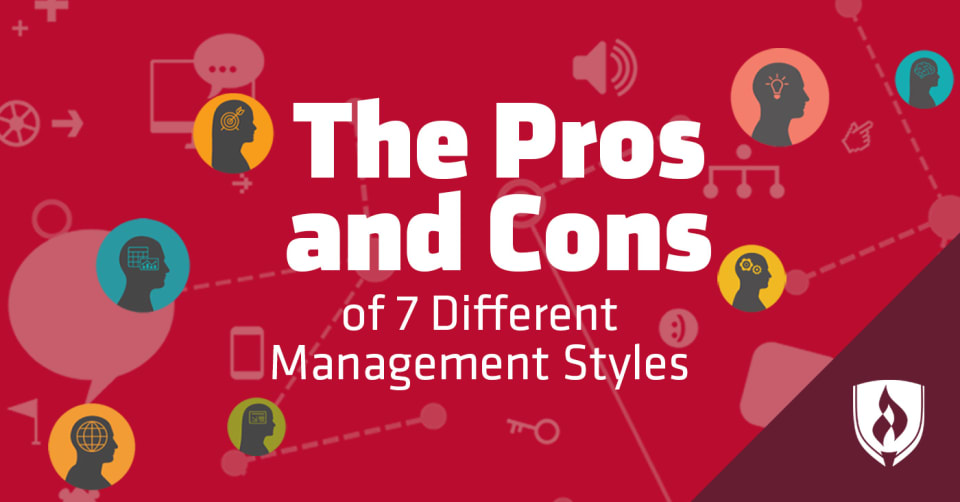
Most managers want to be known as good managers. They want to motivate their employees to the best performance possible, maximize the resources they have and achieve favorable results. But making these goals happen is much easier said than done. What can seem straightforward from the outside becomes an interpersonal balancing act on the job. As managers everywhere will tell you—there’s no one way to manage people.
“To understand management styles, it's important to understand what the core purpose of management is,” says Anshuman Didwania, sales operations lead at Clara Lending . “Management exists to enable coordination of resources (labor or capital) to achieve a very specific outcome.” Didwania says management is valuable because the right coordination can achieve an impact that isn’t possible through individual efforts.
“Management styles are differentiated by how managers coordinate resources,” Didwania says, adding that this is normally a matter of how managers gather, process and act on information. We asked managers to weigh in on the pros and cons of management styles they have seen to give you some ideas on finding a management style of your own.
A closer look at 7 management styles
1. Directive management
“Directive management is all about having full control,” says James Nowlin, founder and CEO of Excel Global Partners . In this management style, the manager makes decisions and directs the employees in their tasks. “Its primary advantage is that the manager is in full control all the time while its primary disadvantage is that the subordinates get very little opportunity for learning.”
“This management style can be very effective in certain industries such as construction or the military,” says Tim Bartholomew, president of Simplified Management . Bartholomew explains that managers in this style don’t exchange input with team members. “When there is only one acceptable way of doing something or the end product has to meet very strict quality standards, this management style can help the work to flow smoothly without a lot of friction or unnecessary delays.”
Bartholomew offers workplaces like operating rooms and ambulances as examples. In situations where even small errors can lead to death or injury, directive management can be the smartest option. But in other areas, it can be problematic.
“In this style, workers are told the ‘What?’ and not the ‘Why?,’” says Joe Kiedinger of Prophit . Kiedinger says this type of management was common for the baby-boomer generation, but that it’s becoming less common today. Kiedinger says the main benefit is speed and efficiency, as the manager’s orders are carried out. “The cons are that people will quit, and it’s difficult to keep good workers engaged. These companies spend more of their resources on recruitment and training than more collaborative counterparts.”
“Employees need to come to you for approvals on all kinds of small things, which often leads to a decrease in productivity and efficiency,” says Steven Benson, founder and CEO of Badger Maps . Benson says micromanaging is very common, even among managers who agree it isn’t effective in their environment. “If you don't give your employees appropriate levels of authority, then their work will suffer, and the organization's progress will slow down.”
2. Coaching management
“Coaching management is all about cultivating the talent and skills of subordinates,” Nowlin says. “Its primary advantage is it encourages a thirst for learning, while its primary disadvantage is it can cause unhealthy competition.”
“A coach breaks down a role, task or skill into parts, and works with each person on how they can improve each part,” Benson says. “I think the most important management skill that you can develop early in your career is to be a great coach.”
Benson says helping each individual reach their full career potential is an important part of building a high-powered workforce. “I teach my employees the strategy and direction of the business and the set of skills they need to be successful,” Benson says. “The goal is to give them the information and knowledge they need to thrive in their role and help them develop through regular training, feedback and one-on-one meetings.”
3. Relational management
This management style is characterized by the trusting relationship built up between the manager and the employees, according to Bartholomew. The goal of relational management is to build a relational foundation that can empower employees to engage and even experiment to capitalize on their strengths. “This type of management style can be slow to provide results,” Bartholomew says. “When a new manager moves into position, they may not be able to get a lot of work done until they build those relationships up.”
In relational management, employees feel more freedom to question the manager when they think they have a better idea. “Sometimes this is a good thing and results in a better process going forward,” Bartholomew says. “Sometimes it's bad in that the results are delayed and there are more failures since new things are tried more often.” In a company built for innovative thought, where there is time to try new things and take some risk, relational management can be the perfect choice that empowers employees to take ownership.
4. Affiliative management
“The type of management style you decide to use in your workplace depends wholly on the type of business you work in and the personality traits of your employees,” says Murat Evin, Creative Director at The London School of Make-Up.
“Using an affiliative management style is great; it creates a harmonious office vibe and encourages employees to speak out about any issues they may have, because they feel relaxed enough to approach management and discuss concerns openly,” Evin explains.
The goal of affiliative management is to have employees and managers working in a collaborative harmony. Creating team chemistry is a big priority in this managing style. Evin says affiliative management is a great way to keep up morale, but it doesn’t leave much room for conflict or a stern approach when something needs to be improved. “As a result, this style of management is less effective when it isn’t used in conjunction with another type of approach,” Evin says.
5. Participative management (also called democratic style)
“The goal is to build a team with an ethos of ‘We’ve got this,’ with a focus on moving the organization forward,” says Kristin Nawoczenski, marketing manager at a full-service travel agency. In participative style management, the employees are encouraged to voice ideas and take responsibility for results. “Open communication and exchange of ideas within the team is encouraged,” Nawoczenski says. “Employees are referred to as colleagues, and members are highlighted when deliverables are presented to upper management.”
Didwania sees this type of management most often in early-stage to mid-stage companies, particularly in Silicon Valley. For example, Didwania says a participative manager might approach the team asking questions like, “What should be our criteria for success?” and “What is the culture we want the team to operate by?” This way, the group’s decisions become a foundation for operations.
To foster this sense of participation, teams in this style use terms like “we” instead of “I” and avoid communication with negative or demanding connotations, Nawoczenski says. But the democratic nature of this management style has to be genuine. Nawoczenski says making employees feel that they can make changes, but not actually giving them the authority to do so will erode motivation and make employees feel undervalued.
“These companies have many meetings and wish for everyone to contribute their ideas in making a decision,” Kiedinger says. “The pros are people feel like they have a voice. They are welcomed to contribute their ideas. The con is a slower process change; the inability to move at the high speed of business.”
6. Pace-setting leadership (aka: leading by example)
“The best managers are people who are talented and confident in their own abilities,” says Richard Scholes, managing director of Parrs. Pace-setting managers lead by their own good example. They work hard and bring the same learning and positive attitude to the job that they expect of their employees. “This acts as an inspiration to others on their team,” Scholes says, adding that the pace-setting manager he knew gave guidance when asked for it. “However, this manager’s team generally learned by watching what the manager did and following their behavior.”
Nowlin has seen some problem areas with pace-setting management. “The manager does plenty of the work in hopes of motivating the subordinates, which sometimes results in subordinates feeling too much pressure to perform as well as the manager.” In this case, the result is employees growing unhappy, who then quit the job. “My best advice to new managers is that they should find a style that plays to their strengths and adheres to their professional and personal beliefs.”
7. Servant leadership
“The servant-leader management style is about giving the manager the autonomy to create their own mini-culture within the broader corporate culture,” Kiedinger says. “This style speaks to every generation currently in the workforce. I would say it closely resembles parenting. We want our kids to learn from their mistakes, so we mentor them and not manage them. Through our counsel, they become independent contributors because their values guide their decisions.”
Kiedinger says leadership training is becoming more and more important for managers today. “We need to go from an age of manager to mentor.” This approach requires a strong commitment to individual employees as well as a firm commitment to professional vision. Managers who oversee large groups of employees or employee groups that shift might not have the time to work this way. A potential downside of the servant leadership style is the temptation for the manager to take on more work and mentoring than is feasible.
What’s your style?
Do you see yourself in some of the management styles mentioned above? Can you picture yourself using some of these mindsets or strategies to help other people thrive in their efforts? As these managers have said, there’s no one-size-fits-all solution to management. The best managers out there bring their talent, natural qualities and hard work together to find the best style for their specific situation.
And while anyone can learn to become an amazing manager, certain traits and skills can make the process much easier. See if you have the qualities of a natural-born manager in our article, “ 5 Managerial Skills You Didn't Realize You Already Had.”
Related Articles:




